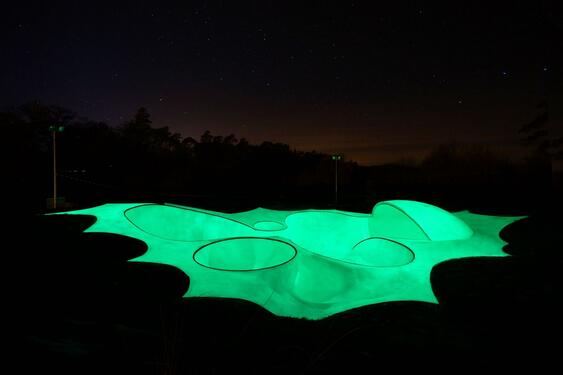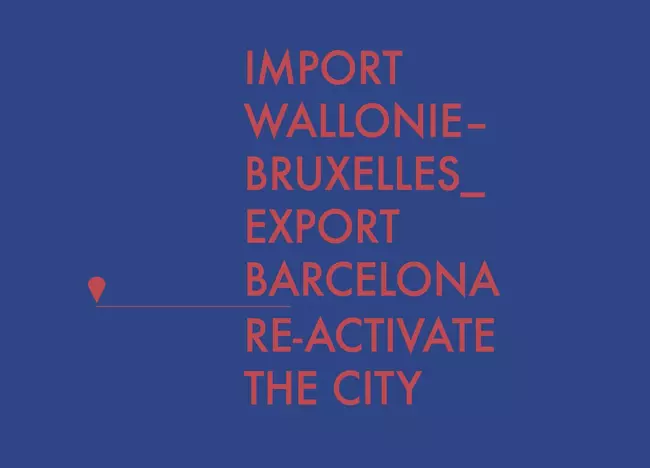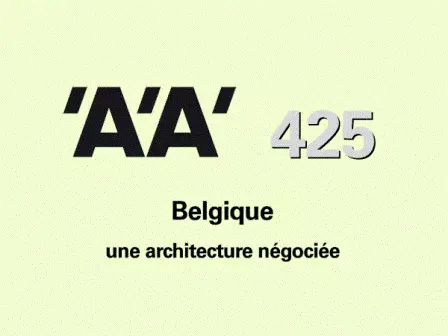- Posts
Published on 31/03/2015
Carte blanche: L'Escaut - "Exporting poetry"

© François Lichtlé L'Escaut has been working in foreign territories already for ten years, mainly in France. This experience has been a great possibility to develop a network of collaborators and test different folk methods of remote work practice. Above all, it gave an opportunity to integrate into a more favorable work environment than the one in Belgium, and bring a certain exotic touch, based on specific culture of Belgian architecture, its dedication to craftwork and attention to details.
The activity of l'escaut outside the Belgian borders is not so recent. The office has started ten years ago by participating in a competition in Fumay, the French Ardennes, with a task to create a landscape design for a leisure park, cited in an abandoned industrial site. Despite the fact that the project was finally aborted, the vision of converting industrial heritage sites stayed a field of interest for the studio, and it feeded all the other projects with a specific philosophy mixing the admiration for the existing objects, exposure of raw materials and particular sensitivity for social history of the places.
Two years later, this project has been followed by an installation of provisional cultural facilities in the Duchy of Luxembourg, in the context of Luxembourg European Culture Capital in 2007. One year later, l'escaut was enlisted for a scenography installation for the Belgian Pavilion in International Expo Zaragoza, Spain, in collaboration with Jan Fabre and a duo of photographers Felten-Massinger. For this particular occasion, l'escaut was first time confronted with a crucial issue of working in distance. Due to that, the office has dedicated two project leaders for work in Spain. In fact, the scale of the project and the impermanence of its realization imposed a permanent presence.
In 2011, another non-standard construction started, one that needed more concretization of an original piece, half a lunar sculpture, half a hallucinated skate park, imagined by an international artist Koo Jeong A, and landed into the island of Vassivière, in the middle of France. L'escaut was invited to coordinate different actors of the project and ensure a technical concept of the structure. For the same reasons, the residence in site became necessary for a few months. Besides that, the opportunity for the remote work has been to some extent an option too, even hundreds of kilometers away from Belgium. The privilege of participating in weekly team meetings stayed possible, even by communicating in distorted voices and faces pixelated by Skype.
Today l'Escaut is handling three projects abroad, all of them located in France. This time the more classical architecture and scenography missions – two new constructions and one rehabilitation project. Each of these three projects is handled in collaboration with French studios. Is this an accident, or is it a secret method to pierce through the armor and enter the French market?
Two of these projects were developed in collaboration with Raum, an architecture studio from Nantes, our favored partner that we are much fond of. The construction of the Pont Supérieur, an extension of a regional conservatory and centre for higher education in music and dance, is currently being finalized. We find this type of collaboration exemplary, especially in comparison with other professional experiences, as it has permitted to assemble the practices of each studio. Raum has imported their rational simplicity and efficiency in the design, whereas l'escaut has accompanied with the arrangement of generous and appropriate space solutions both for the exterior as well as interior, all the more that the building serves for the public function too.
In 2014, this time in the territory of Aiguillon-sur-mer, in the Vendée region, a place sadly famous for the deadly natural disaster Xynthia, the same association is assigned with a project mission of the interpretation centre dedicated not only to the disaster, but as well to the coastline history. Here, in addition to working on the architectural aspect, l'escaut holds the responsibility for the task of exhibition design.
Very soon l'escaut will inaugurate a cultural centre in Reims. Once again working in the association, with a studio Tandem+ from Lille, this time l'escaut plays a role of leading office. This building, named Le Cellier by the inhabitants of Reims, an ancient space for champagne trading and stock, has had its interior rehabilitated (the exterior facades are classified), setting up a space for creation and representation of living art, including exhibition and education activities. The type of selection set by the project contractor was quite unusual, as along with the open application procedure, the dossier of the proposal was limited to around ten pages of methodology notes. It was rather more an inquiry for «a project philosophy », than for the precise concept. In total, 143 project reports were submitted.
In recent years, l'escaut regularly monitors the market opportunities in France, constantly applies for different competitions and keeps on getting the chance to compete, either in a team or on its own.
We must admit that we found the work conditions in the French Hexagon excellent so far. The team base is mostly selected in consideration with the time needed for the project development at the conception level, which involves a considerable investment into the concept study and its representation. In France, the competition phase is often compensated at the cost of the work really done. Meanwhile the "reimbursements" paid in Belgium for an equivalent level of expected benefits never manage to amortize the investments in human resources.
Moreover, we find that the tendering procedures are often better organized and supervised by the point of view of regulations. The MOP law for the public sector contractors is a very good example. We may also mention the lack of presence of project program developers and economists, which are almost non-existent jobs in Belgium. On one hand they still allow to anticipate optimally in the content of a project, and yet they partly relieve the architect of certain technical burdens, enabling him to exercise its best as a mediator. Noting also the fact that it leads to the commendable project budgeting in France, that allows architecture of a greater quality.
In the end, this is clearly in a paradoxical manner that we operate in the French territory. The architecture and construction culture of the Belgian architects is regarded with praise in recent years, but from our point of view, we remain fascinated by the quality of the work environment that prevails there. In this case, crossing the border allows us to take the best of both sides.
By L'Escaut
- BilletsAuteur
Audrey ContessePublished on 09/10/2018
-
Allier procédure et processus
"La scène belge est gage de qualité, d’humanisme et de poésie" peut-on lire dans le numéro 425 de l’Architecture d’Aujourd’ hui, dévolu à l [...]
- BilletsAuteur
Emmanuelle BornePublished on 06/07/2018
-
Belgitopie
Faut-il se fier aux expositions internationales, a fortiori à la Biennale d’architecture de Venise, pour appréhender les mouvements de fond et enjeux [...]



